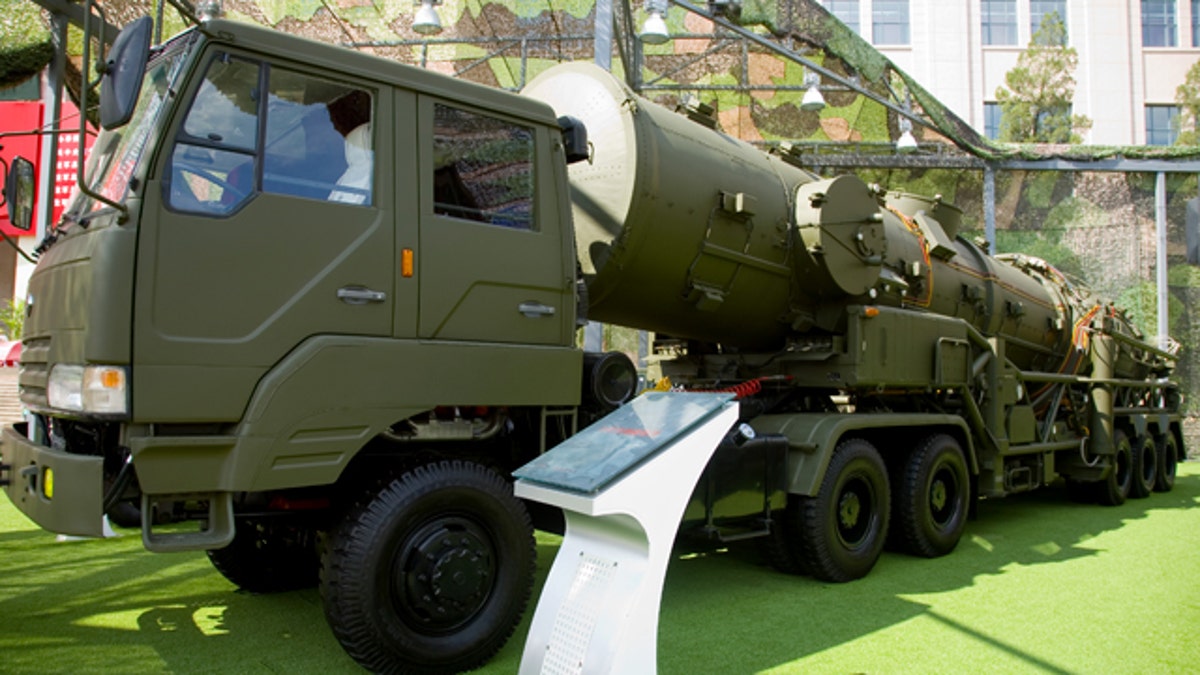
The Dong Feng 21A and launcher vehicle are displayed at the Beijing Military Museum. China is reportedly working on developing the world's first antiship ballistic missile based on a similar design. (Max Smith / Wikipedia)
China is developing an unprecedented new missile that is designed to be launched from land with enough accuracy to penetrate the defenses of even the most advanced moving aircraft carrier from a distance of more than 900 miles, sources say.
Initial reports on the new missile suggest it could reshape conflicts at sea, but U.S. weapons experts told FoxNews.com that it's no game-changer, nor a revolutionary threat to America's aircraft carriers -- which are the center of U.S. Pacific defense strategy.
"Some have called it a game-changer. I would dispute that claim," said Toshi Yoshihara, an associate professor at the U.S. Naval War College.
When complete, the Dong Feng 21D -- a version of which was displayed last year in a Chinese military parade -- would give China the ability to reach and hit U.S. aircraft carriers well before the U.S. can get close enough to the mainland to hit back.
A nuclear bomb could theoretically sink a carrier, too, assuming its sender was willing to raise the stakes to atomic levels. The conventionally armed DF 21D's uniqueness is its ability to hit a powerfully defended moving target with pinpoint precision.
"The emerging Chinese anti-ship missile capability, and in particular the DF 21D, represents the first post-Cold War capability that is both potentially capable of stopping our naval power projection -- and deliberately designed for that purpose," said Patrick Cronin, senior director of the Asia-Pacific Security Program at the nonpartisan, Washington-based Center for a New American Security.
Details of the missile are still unknown, and the county has yet to test the system. Yoshihara said China would need to rely on a range of technologies to track boats and guide the warhead to a moving target like a carrier.
"There would be several layers of sensors, including over-the-horizon radar, which would help track surface units. They also have airborne sensors to look out into the Pacific, as well as space-based satellites to track a strike group." Three layers of targets would provide a very accurate snapshot with which to precisely guide a missile.
But questions remain about how fast China will be able to perfect its accuracy to the level needed to threaten a moving carrier at sea.
"This is probably one of the biggest mysteries," Yoshihara said. "My quick answer is we don’t know."
"Yes it's a very large target, but it's operating in the vast expanse of the Pacific. Besides, we're talking about a warhead falling onto the earth at 10 times the speed of sound. How do you guide it in pinpoint fashion?"
Even as the Chinese are developing the DF 21D, the U.S. Navy is working on counter technologies. "They're already investing in missile-defense systems designed specifically to defend against anti-ship ballistic missiles," Yoshihara pointed out.
This isn't the first time such a system has been attempted; the Soviet Union tried to build anti-ship ballistic missiles during the Cold War -- and abandoned the program as too challenging.
Meanwhile, weapons such as the nuclear bomb were far more important factors in changing the shape of military conflicts, Yoshihara noted. "The advent of an anti-ship ballistic missile simply increases the cost of us contemplating intervention in, say, Taiwan," he noted. Such a missile system may give military commanders second thoughts before engaging in a certain area, or reduce U.S. options in times of crisis, he added.
Still, there have been enough advancements in technology that such a missile system is far more realistic than before -- a question of when rather than whether. Ultimately, the new missiles may lead to long-term shifts in strategy more than anything.
Should the U.S. adjust its investment from air to sea, and boost research and spending in submarines? And do pinpoint accurate missiles alter the military's strategy, since formerly safe bases in the area are equal targets?
"If those missiles can reach carriers in the open ocean, they can target critical naval bases all along the Pacific Rim," Yoshihara said.
"That challenges the basic principle of American power projections in the Far East."




















